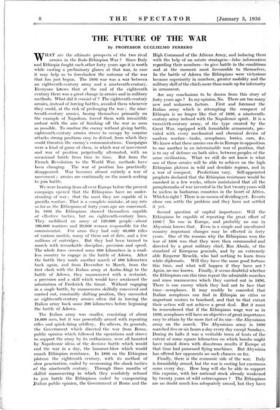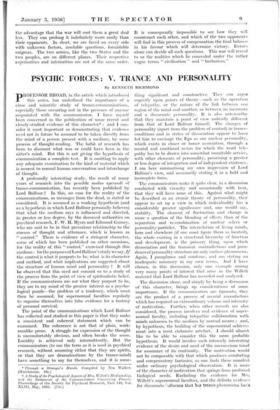THE FUTURE OF THE WAR
By PROFESSOR GUGLIELMO FERRERO
WHAT arc the ultimate prospects of the two rival armies in the Italo-Ethiopian War ? Since Italy and Ethiopia fought each other forty years ago it is worth while casting a preliminary glance at that war, in case it may help us to foreshadow the outcome of the war that has just begun. The 1896 war was a war between an eighteenth-century army and a nineteenth-century. Everyone knows that at the end of the eighteenth century there was a great change in armies and in military methods. What did it. consist of ? The eighteenth-century armies, instead of forcing battles, avoided them whenever they could, at the risk of prolonging the war ; the nine- teenth-century armies, basing themselves primarily on the example of Napoleon, forced them with irresistible ardour with the aim of finishing off the war as soon as possible. To confuse the enemy without giving battle, eighteenth-century armies strove to occupy by surprise attacks strong positions easy to defend, from which they could threaten the enemy's communications. Campaigns were a kind of game of chess, in which war of movement and war of position perpetually alternated, with an occasional battle from time to time. But from the French Revolution to the World War, methods have been changing. The war of position has practically disappeared. War becomes almost entirely a war of movement ; armies are continually on the march seeking to join battle.
We were hearing from all over Europe before the present campaign opened that the Ethiopians have no under- standing of war ; that the most they are capable of is guerilla warfare. That is a complete mistake, at any rate so far as the Ethiopians of forty years ago are concerned. In 1896 the Ethiopians showed themselves capable of effective tactics, but on eighteenth-century lines. They mobilised an army of 120,000 people—about 100,000 warriors and 20,000 women responsible for the commissariat. For arms they had only 80,000 rifles of various models, many of them out of date, and a few millions of cartridges. But they had been trained to march with remarkable discipline, precision and speed. The whole force covered some 600 kilometres in a road- less country to engage in the battle of Adowa. After the battle they made another march of 600 kilometres back again, and from December to March, from the first clash with the Italian army at Amba-Alagi to the battle of .Adowa, they manoeuvred with a restraint, a precision and a skill which would have awakened the admiration of Frederick the Great. Without engaging in a single battle, by manoeuvres skilfully conceived and carried out, constantly shifting position, they succeeded as eighteenth-century armies often did in forcing the Italian army back some 200 kilometres before beginning the battle of Adowa.
The Italian army was smaller, consisting of about 18,000 men, but it was powerfully armed with repeating rifles and quick-firing artillery. Its officers, its generals, the Government which directed the war from Rome, public opinion which followed the operations and strove to support the army by its enthusiasm, were all haunted by Napoleonic ideas of the decisive battle which would end the war in a clay, the hammer-blow which would smash Ethiopian resistance. In 1896 on the Ethiopian plateau the eighteenth century, with its method of slow penetration, ended by overcoming the shock tactics of the nineteenth century. Through three months of skilful manoeuvring in which they resolutely refused to join battle the Ethiopians ended by exasperating Jtalian public opinion, the Government at Rome and the High Command of the African Army, and inducing them. with the help of an astute stratagem—false information regarding their numbers—to give battle in the conditions and at the moment most favourable to themselves. In the battle of Adowa the Ethiopians were victorious because superiority in numbers, greater mobility and the military skill of the chiefs more than made up for inferiority in armament.
Are any conclusions to be drawn from this story of forty years ago ? In my opinion, No. There are too many, new and unknown factors. First and foremost the Italian army which is attempting the conquest of Ethiopia is no longer like that of 1896, a nineteenth- century army imbued with the Napoleonic spirit. It is a twentieth-century army, of the type created by the Great War, equipped with formidable armaments, pro- vided with every mechanical and chemical device of modern warfare—tanks, aeroplanes, lorries, cars, &c. We know what these armies can do in Europe in opposition. to one another in an interminable war of position, that is to say of defence on both sides, between peoples of the same civilisation. What we still do not know is what one of these armies will be able to achieve on the high Ethiopian plateau in wild and desolate regions, and in a war of conquest. Predictions vary. Self-appointed prophets declared that the Ethiopian resistance would be smashed in a few weeks, others maintained that all the paraphernalia of war invented in the last twenty years will be useless in barbarous countries in the heart- of Africa. Which is right? There is no means of deciding yet. Events alone can settle the problem and they have not settled it yet.
Second question of capital importance. Will the Ethiopians be capable of repeating the great effort of 1896?. No one in Europe, and probably no one in Abyssinia knows that. Even in a simple and uncultured country important changes -may be effected in forty years. One of the reasons why the Ethiopians won the war of 1896 was that they were then commanded and directed by a great military chief, Ras Aloula, of the standard of European generals, and by an extremely able Emperor Menelik, who had nothing to learn from - white diplomats. Will they have the same good fortune this time, and what will happen if they have not ? Again, no one knows. Finally, it seems doubtful whether the Ethiopians can this time repeat the admirable marches and mass manoeuvres which they carried out in 1896. There is one enemy which they had not to face that time—aeroplanes. It may readily be conceded that Italian aeroplanes can find in Ethiopia no cities or important centres to bombard, and that to that extent their action will not achieve a great deal. But it must be remembered that if the Ethiopians wage war as in 1896, aeroplanes will have an objective of great importance easy to attain by the mere fact of its size—the Abyssinian army on the march. The Abyssinian army in 1896 marched five or six hours a day every day except Sundays. During its halts it was a veritable town of tents of the extent of some square kilometres on which bombs might have rained down with disastrous results if Europe at that time had possessed flying machines. But Abyssinia has offered her opponents no such chances so far.
Finally, there is the economic side of the war. Italy is formidably armed, but the war is costing her enormous sums every day. How long will she be able to support this expense, with her national stock already weakened by twenty years of wild extravagance ? The Ethiopians are no doubt much less adequately armed, but they have the advantage that the war will cost them a great deal less. They can prolong it indefinitely more easily than their opponents. In short, we are faced on every side with unknown factors, insoluble questions, formidable enigmas. The two armies, like the two States and the two peoples, are on different planes. Their respective superiorities and inferiorities are not of the same order. • It is consequently impossible to see how they will counteract each other, and which of the two opponents will find in this process of compensation the final balance in his favour which will determine victory. Events alone can decide all such questions. This war will reveal to us the realities which lie concealed under the rather vague terms "civilisation " and " barbarism."











































 Previous page
Previous page